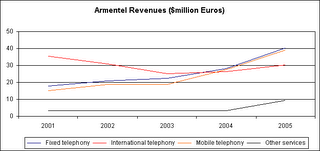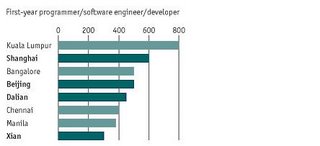The BEEPS survey data prepared by the World Bank and EBRD is one potential source of data on transition economies. This business environment survey data provides information on the behavior and attributes of enterprises as well as select indicators of governance. The World Bank provides summary tabulations as well as makes the raw data available for research (see here for the BEEPS data).
Using data for 2002, the latest year where raw data is available (only tabulations of data for the 2005 survey are currently available), and discarding public enterprises, we find that Armenian firms hide 9 percent of their sales or output. This is far less than the experience of many other transition economies surveyed. Correcting for the dispersion around this mean (large standard deviations), the differences might be smaller.
Country %Mean Std. Dev.
Albania 0.25 0.23
Armenia 0.09 0.17
Azerbaijan 0.15 0.25
Belarus 0.10 0.18
Bosnia 0.34 0.34
Bulgaria 0.17 0.23
Croatia 0.13 0.18
Czech Rep 0.11 0.17
Estonia 0.08 0.13
Macedonia 0.37 0.30
Georgia 0.39 0.28
Hungary 0.12 0.20
Kazakhstan 0.17 0.26
Kyrgyzstan 0.26 0.29
Latvia 0.14 0.22
Lithuania 0.16 0.25
Moldova 0.23 0.25
Poland 0.11 0.18
Romania 0.15 0.20
Russia 0.19 0.25
Slovakia 0.14 0.19
Slovenia 0.19 0.29
Tajikistan 0.29 0.30
Turkey 0.17 0.21
Ukraine 0.16 0.27
Uzbekistan 0.10 0.21
Yugoslavia 0.26 0.30
Should we believe the BEEPS data? One way to explore the quality of the data is to examine how the size of hidden output varies by say the frequency of bribes to tax officials. Here we find that more of the sales of a firm are understated when bribes are more common. Indeed, they tend to increase with the frequency of bribes. Firms that report bribes to Never take place report 12 percent of sales to be hidden. In contrast, 31 percent of sales are reported to be hidden when bribes to tax officials Always take place.
BribeFrequency %Mean StdDev
Never 0.12 0.21
Seldom 0.21 0.25
Sometimes 0.21 0.24
Frequently 0.28 0.27
Usually 0.31 0.27
Always 0.31 0.28
The same tendencies are observed when the unreported fraction of sales are regressed on the frequency of bribes, with corrections for censoring (not every firm cheats) and sample selection (some firms refuse to participate in the survey).
BribeFrequency Coeff StdErr
Seldom 0.2174 0.0205
Sometimes 0.2282 0.0218
Frequently 0.3230 0.0254
Usually 0.3650 0.0360
Always 0.3615 0.0413
The extent of the share of sales hidden in the survey data is ascertained by the following question:
... what per cent of total annual sales would you estimate the
typical firm in your area of business reports for tax purposes?
Some may view this as a potential weakness in that we are not told of the amount under reported by the firm. Others may view this as its strength in that firms don't have to lie about their behavior. In any event, the above findings are extensively discussed in my recent paper (click here). When I limited the econometric work to Armenia instead of the cross section of transition economies, all the results fell apart. Obviously there is more to the hidden economy and its determinants than my work suggests. I would very much like to hear about the experience of others on this subject.
With the holidays and other commitments, I may not be able to contribute to this blog between now and January 7. This being the season of giving, please consider sponsoring a student, a teacher, or, if it is within your means, a school in Armenia.




 Are there any studies exploring the reasons for this trend?
Are there any studies exploring the reasons for this trend?